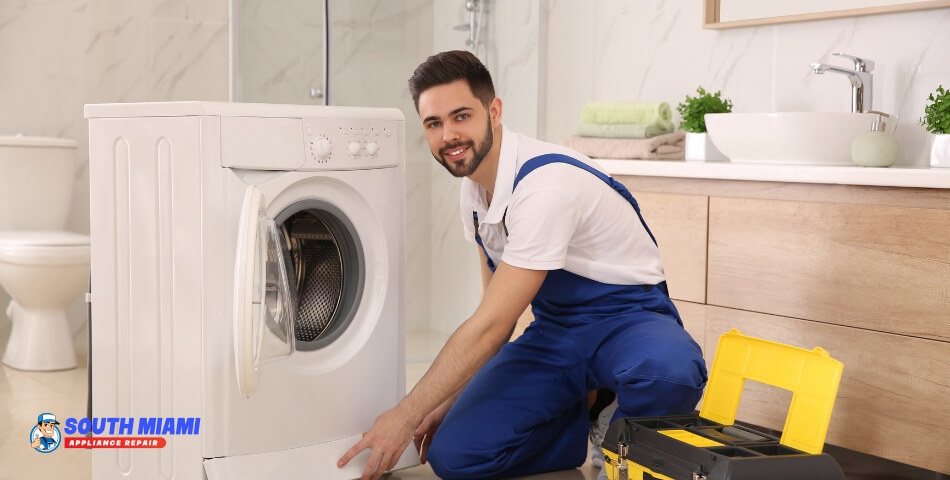What Is The Most Common Reason For Washer Leaking From Bottom
If your washing is leaking from the bottom, you should first try to determine if it is the water hose leaking. A damaged water hose typically causes a leaky washer. The water hose can typically be found at the back of a washing machine.
This article has compiled a list of the most common reasons for your washer leaking from the bottom and what to do to fix them.
What Faulty Parts Can Lead to a Washer Leak?
The following is a list of the main reasons why the washer is leaking from the bottom:
- Water Hoses – They can be sagging and dripping on the wall or washing, resulting in a back leak.
- Tub Cover Gasket might be harmed and have a front water leak.
- Drain Pump– Possibly clogged with lint or dirt, leading to a bottom leak.
- Water Inlet Valve – A leak coming from the back/bottom may be the result of anything being broken, loose, or clogged.
- Door Catch – If this part is damaged, water may flow out of the locked door because it holds it in place.
- Boot Seal/Tub Seal – The basket shaft enters the tub through the transmission shaft, which, if damaged, can cause leaks from the bottom.
- Bellows or Door Boot Seal – During the fill or spin cycle, they may be harmed on front loaders, leading to a front water leak.
- Water Level Switch/Pressure Switch – These switches determine the right water level, which, if destroyed, might lead to overfilling.
It’s important to determine where the leak is coming from before you begin debugging. It may appear that your washer is leaking from the bottom if it is leaking from the back. This is due to the water’s tendency to run forward and frequently emerge from beneath the washing machine.
Check For A Leaky Water Hose
- As this is the most common reason for your washing machine leaks, it is a good idea to start by checking it first.
- Always start by unplugging any appliances from the power outlet you plan to work on.
- The washer should now be moved around 12 inches from the back wall. Take great care to prevent water hose damage.
- Find the water hoses behind the washer by taking a look behind it.
- Look for the water hose connections. The wall will be at one end, and the washer’s back will be at the other.
- Examine the hoses attached to the water outlets to see if any are loose. If so, firmly join them by hand-tightening them.
- Finally, ensure that none of the hoses attached to the washer are loose. If so, firmly tighten them together by hand.
Additionally, look over these hoses for any obvious damage. This might potentially bring on a leak.
Make sure the rubber seal on your washing machine is not leaking.
Although the rubber seals on your washing machine are incredibly strong, they occasionally grow brittle and start to leak.
- Examine water connections and hoses to identify where the leak is coming from.
- To check for moisture or damage, use your palm to feel the connections’ surrounding area.
- Ensure it is put securely and correctly if you discover moisture or one of the connections is leaking.
- Drain any water in the hoses after turning off the water. For any damage, inspect the water hose washers.
- Replace all the water hose washers with new ones and reconnect if any are damaged. You can avoid having to return in a few more weeks by completing them all at once.
Check That The Leak is Not Being Caused By Your Washer’s Drain Hose.
Sometimes the drain hose malfunctions instead of the washing machine being the source of the leak.
- Ensure the drain hose is inserted no deeper than 6 inches into the standpipe or tub.
- Ensure the drain hose is securely fastened so it cannot come undone and slide down.
- Consider attaching the drain line to the standpipe with a zip tie.
- Verify that your washing machine is completely level and not at an angle.
Check That The Leak is Not Being Caused By The Washer Drain Pump.
You can finally check if the washer drain pump is causing the leak.
- Look for leaks in the drain pump region, which is at the base of your washer.
- Check for leaks or damage on the water hoses leading to and from the drain pump.
- Examine all of the hose clamps on the drain pump’s water lines. You should make sure they are still well-fastened and undamaged.
- It is a simple fix if you discover a leaky water hose on the drain pump. To halt the leak, tighten it.
- You must replace the drain pump if you discover a broken water line or hose clamp there to stop the leak.
After doing those possible solutions and if you still have issues after running through the troubleshooting options listed above, you should call a certified expert at South Miami Appliance Repair for exceptional and cost-effective washer repair.

